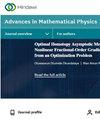两种不同非线性的分数阶复Ginzburg-Landau模型的广义指数有理函数法解析解
IF 1.1
4区 物理与天体物理
Q3 PHYSICS, MATHEMATICAL
引用次数: 4
摘要
复杂的金兹堡-朗道模型出现在非线性光学波传播的数学描述中。本文用广义指数有理函数方法研究了分数阶复金兹堡-朗道模型。利用克尔定律和抛物定律讨论了模型的非线性。分数效应还包括了一个新的局部分数阶导数的阶α。利用广义指数有理函数方法,得到了许多包含三角函数、双曲函数和指数函数的新解。利用Maple软件绘制了部分检索解的三维曲面图、二维轮廓图、密度图和二维线形图。报道了各种精确行波解,包括暗孤子解、亮孤子解和扭结孤子解。光学孤子的性质通过获得的导数分数阶变化解的图形表示来证明。希望获得的解将有助于理解由所考虑的模型控制的各种物理现象和动态过程的动力学。本文章由计算机程序翻译,如有差异,请以英文原文为准。
Analytical Solutions of the Fractional Complex Ginzburg-Landau Model Using Generalized Exponential Rational Function Method with Two Different Nonlinearities
The complex Ginzburg-Landau model appears in the mathematical description of wave propagation in nonlinear optics. In this paper, the fractional complex Ginzburg-Landau model is investigated using the generalized exponential rational function method. The Kerr law and parabolic law are considered to discuss the nonlinearity of the proposed model. The fractional effects are also included using a novel local fractional derivative of order
α
. Many novel solutions containing trigonometric functions, hyperbolic functions, and exponential functions are acquired using the generalized exponential rational function method. The 3D-surface graphs, 2D-contour graphs, density graphs, and 2D-line graphs of some retrieved solutions are plotted using Maple software. A variety of exact traveling wave solutions are reported including dark, bright, and kink soliton solutions. The nature of the optical solitons is demonstrated through the graphical representations of the acquired solutions for variation in the fractional order of derivative. It is hoped that the acquired solutions will aid in understanding the dynamics of the various physical phenomena and dynamical processes governed by the considered model.
求助全文
通过发布文献求助,成功后即可免费获取论文全文。
去求助
来源期刊

Advances in Mathematical Physics
数学-应用数学
CiteScore
2.40
自引率
8.30%
发文量
151
审稿时长
>12 weeks
期刊介绍:
Advances in Mathematical Physics publishes papers that seek to understand mathematical basis of physical phenomena, and solve problems in physics via mathematical approaches. The journal welcomes submissions from mathematical physicists, theoretical physicists, and mathematicians alike.
As well as original research, Advances in Mathematical Physics also publishes focused review articles that examine the state of the art, identify emerging trends, and suggest future directions for developing fields.
 求助内容:
求助内容: 应助结果提醒方式:
应助结果提醒方式:


